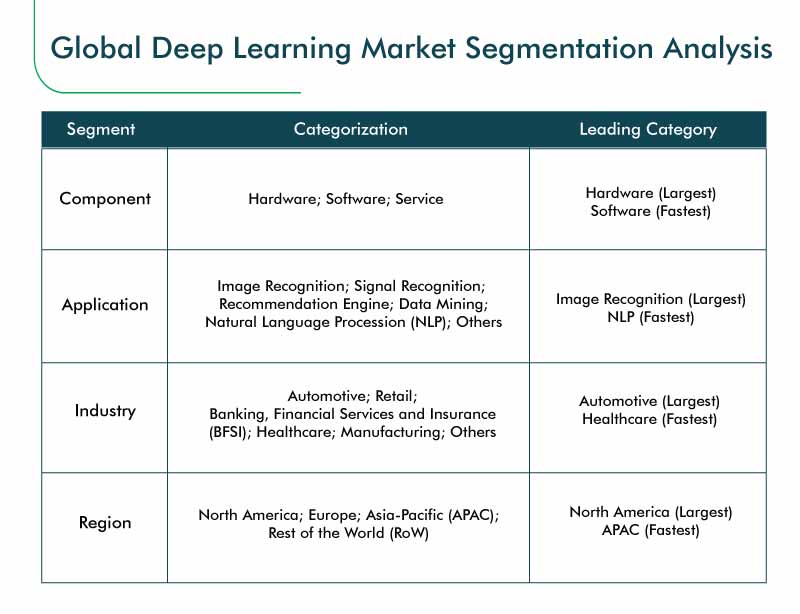Deep Learning Market to Generate Revenue Worth $102.4 Billion by 2030
- Published: February 2020
Valued at $3.7 billion in 2019, the global deep learning market is projected to reach $102.4 billion by 2030, demonstrating a CAGR of 35.2% during the forecast period (2020–2030). Among all industries, the healthcare industry is expected to witness the highest demand for deep learning solutions during the forecast period. This is due to the increasing adoption of AI technologies, such as machine learning (ML), deep learning, and big data, in the healthcare industry to support medical professionals and researchers in data extraction and analysis for better medical outcomes.
Rising Adoption of Deep Learning Solutions in Healthcare – A Key Trend in Market
The growing adoption of deep learning solutions in the healthcare industry can be viewed as one of the key trends in the market. Deep learning aids in drug discovery and development by enabling deeper analysis and understanding of the medicinal properties of new compounds. Besides, the technology helps analyze a patient’s medical history to recommend the best treatment possible. Deep learning solutions can also be leveraged along with medical imaging techniques such as MRI scans, CT scans, and ECG for the diagnosis of critical diseases for improved treatment.
Cost Savings Facilitated by Deep Learning Algorithms Driving Market Growth
Deep learning is a subset of ML concerned with the exploration and building of algorithms that enable computers to continuously learn and adapt. The complex relationship of data sets often makes it difficult to implement analysis methods such as hypothesis testing and regression analysis. In such scenarios, deep learning solutions enable systematic coding and classification of data sets, thereby increasing visibility in terms of errors in datasets and reducing the need for humans to manually analyze each set for comparison. This, in turn, results in massive cost savings.
Segmentation Analysis of Deep Learning Market

- The software category is expected to witness the fastest growth in the deep learning market during the forecast period. Businesses are increasingly adopting scalable deep learning software for various applications, such as voice assistance, image recognition, and signal recognition.
- Image recognition was the largest application area of deep learning solutions in 2019, with the category accounting for the highest revenue in the market. This can be attributed to the high demand for deep learning solutions for image recognition applications, as these help users in detecting and identifying objects and analyzing digital images.
Geographical Analysis of Deep Learning Market
Together, North America and Europe are expected to hold over 55% share in the deep learning market in 2030. This can be mainly attributed to technological advancements, increasing investments in AI technologies by governments and industries, and presence of a large number of market players in these regions. In terms of growth, however, the market is expected to register the highest CAGR in APAC during the forecast period. This can be attributed to the rising economic growth, increasing investments in IT infrastructure, growing adoption of advanced technologies, and increasing number of AI startups in the region.
Competitive Landscape of Deep Learning Market
The global deep learning market is highly competitive in nature, with the presence of a large number of established companies, such as Alphabet Inc., Amazon Web Services Inc., Microsoft Corporation, NVIDIA Corporation, IBM Corporation, Intel Corporation, Qualcomm Incorporated, Baidu Inc., and SAS Institute Inc.
In recent years, major players in the deep learning market have taken several strategic measures to strengthen their market position. For instance, in October 2018, Microsoft Corporation announced a partnership with Qualcomm Incorporated to provide a vision AI developer kit that integrates cognitive and ML capabilities and visual technologies in edge devices that provide an entry point into the service provider’s core networks.
Browse report overview with detailed TOC on "Deep Learning Market Research Report: By Component (Hardware, Software, Service), Application (Signal Recognition, Image Recognition, Data Mining, Recommendation Engine, NLP), Industry (BFSI, Healthcare, Automotive, Manufacturing, Retail) - Global Industry Analysis and Growth Forecast to 2030" at:https://www.psmarketresearch.com/market-analysis/deep-learning-market-report
Moreover, in September 2018, Microsoft Corporation announced the acquisition of Lobe Artificial Intelligence Inc., a startup that lets a user create deep learning models with a simple drag-and-drop method. Under the agreement, it was decided that Lobe Artificial Intelligence would continue functioning as a standalone service provider and would leverage Microsoft’s infrastructure and experience in AI research and developer tools for improved services.